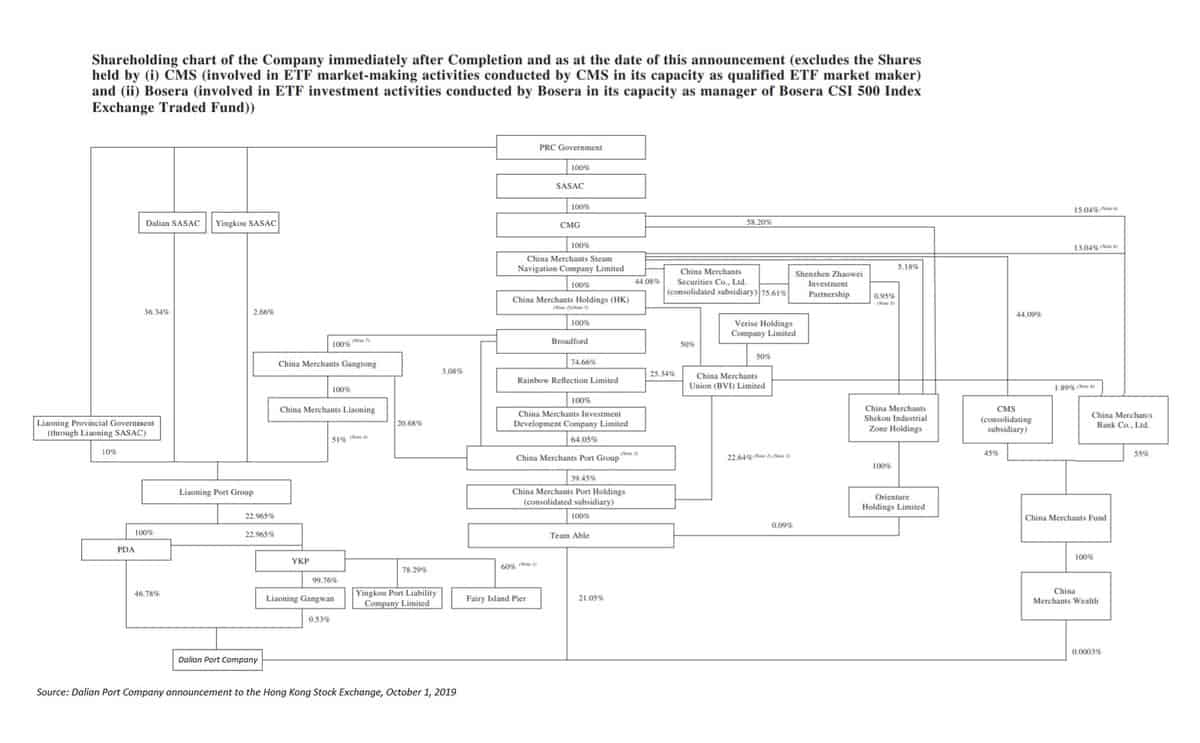China continues seaport consolidation as Dalian offer goes unconditional
Broadford Global has made a mandatory unconditional offer for all the H shares in the dual-listed Dalian PortCo. (HKEX: 2880 and SSE: 601880) of Liaoning Province, China.
The offer for Dalian Port will close on Oct. 28.
A complex deal
It’s a phenomenally complex deal, with multiple levels of corporate ownership of Dalian Port. Broadford Global is just one of a multitude of companies involved in the group structure. In a nutshell, the commercial beneficial owner of Dalian Ports is the China Merchants Group, which has effective — albeit indirect — control of Dalian Ports. The ultimate and final owner is the government of the People’s Republic of China.
David Blennerhassett, a sell-side analyst with Quiddity Advisors, who publishes on the SmartKarma platform, wrote that, following the restructuring, the various PRC-government-related companies now hold about 68.7% of Dalian Port. He adds that China Merchants Group “intends to maintain Dalian Port’s listing and will take steps to restore the public float should the need arise”.

Spaghetti Junction: how Dalian Port (bottom left) fits into the wider group of interlocking companies. The text at the top of the image is by David Blennerhassett, a sell-side analyst with Quiddity Advisors.
Province-by-province consolidation
The companies within the complex corporate structure have been swapping bits of equity around the group so Beijing can consolidate ownership of the seaport at the provincial level of government. A Chinese province is somewhat equivalent to a U.S. state.
China’s Ministry of Transport reports on about 58 seaports of various sizes that handle a wide range of cargoes. There are also numerous river ports. In 2014, Beijing began pushing for consolidation of port ownership and operation in China to increase efficiency by reducing duplication, waste, overcapacity and competition. FreightWaves understands that approximately 18 Chinese provinces have been ordered to integrate their ports under common ownership. The first to do so was Zhejiang Province in 2015.
“Following the success of merging all ports in Zhejiang Province in 2015, China’s Ministry of Transportation has pushed for the consolidation of ports in [the provinces of] Hainan, Jiangsu, Liaoning — amongst others,” Blennerhassett wrote.
Zhejiang Province: a port-integration success story
Zhejiang is one of the smaller coastal provinces and is immediately south of the city/province of Shanghai. Ports in Zhejiang include Jiaxing, which had a throughput of 900,000 ocean shipping containers as measured by twenty-foot equivalent units (TEUs) in the first half of 2019. Also in Zhejiang province are Ningbo-Zhoushan (13.9 million TEUs), Taizhou (160,000 TEUs) and Wenzhou (390,000 TEUs).
The provinces of Jiangsu and Guangxi have also reportedly completed port integration. Jiangsu is a small province immediately north of Shanghai. It is home to the ports of Lianyungang (2.4 million TEUs) and Yanchang (120,000 TEUs). Guangxi is a larger province in the far south of China near Hainan Island. Guangxi Province is home to Guangxi Beibu Gulf Port (1.59 million TEUs); Beihai Port (140,000 TEUs); Qinzhou (1.27 million TEUs) and Defense City (180,000 TEUs).
Ports in Liaoning Province
Dalian Port (4.36 million TEUs), is located on the Liaodong peninsula about 286 miles east-by-south of the Chinese capital, Beijing. The other main seaports in Liaoning Province are Dandong (290,000 TEUs), Yingkou (2.81 million TEUs), Panjin (140,000 TEUs), Jinzhou (880,000 TEUs) and Huludao (30,000 TEUs). Liaoning Province shares a border with North Korea.
Dalian, Jinzhou and Yingkou — near-neighbour ports in the Bohai Bay area — are all under the control of Liaoning Port Group, which is also part of the complex group structure and which will be used to integrate the ports of Liaoning Province. Blennerhassett reports that a 10 billion-yuan bond was issued earlier this year to help integrate the ports of Dalian, Jinzhou and Yingkou.
About Dalian Port
Dalian provides a wide range of marine and port services. These include handling of oil and liquefied chemicals along with related logistics services; ocean shipping containers; vehicles and related logistics services; break bulk and general cargo; bulk grain; passenger; and roll-on and roll-off services.
Dalian recently reported 3.22 billion yuan (US$456.1 million) of revenues generated in the first half of 2019, of which 1.33 billion yuan came from handling ocean shipping containers. Throughput of oil and liquefied chemicals made up another 869 million yuan. Bulk cargo throughput generated 426 million yuan. The rest of the port’s revenues were generated by grain, passengers and other services.
Although boxes were the largest revenue source, they generated only about 125 million yuan of profit. The vast majority of Dalian’s profit, about 303 million yuan, came from oil and liquefied chemicals. The main driver of the oil profits was higher revenue from handling and storage as volumes of crude oil throughput increased throughout the year.
As the port also made substantial losses in some of its business segments. For instance, it made an aggregate loss of 165 million yuan on “other” services and a 12 million yuan loss on bulk grain handling. The total net profit after taking into account segment-by-segment profits and losses was 354 million yuan.
HEADLINES
- Do shipping markets want Biden or Trump for the win?
- All 18 crew safe after fire on Japanese-owned tanker off Singapore
- Singapore launching $44m co-investment initiative for maritime tech start-ups
- Cosco debuts Global Shipping Industry Chain Cooperation Initiative
- US warns of more shipping sanctions
- China continues seaport consolidation as Dalian offer goes unconditional